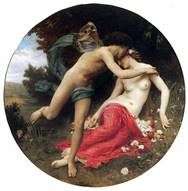
The work “Flora and Zephyr” was written by Adolf Bugero, based on the ancient Roman myth about the wives Zephyrus – the western lung and the warm Mediterranean wind and Flora – the young goddess of spring and flowers. The author used the Roman interpretation of the tale as the basis, while Greek mythology called Zefir a strong, gusty hurricane with rain.
The scene that Bugero paid attention to embodies the love and interweaving of the first signs of the awakening of nature from hibernation. The image of Flora, fragrant, almost transparent, is nothing but a primrose at the end of winter. Her husband – a young Zephyr with the wings of a motley butterfly, – as if he was pollinating the opened bud with his attention, kisses, gentle gusts of touch. They are beautiful, they do not know that Morena, Queen of Winter, is afraid of their hot feelings and the maturity of kisses. Bugero wrote the main lovers according to the tradition of biblical tales. In the manner of performance, ancient notes are read, although the canvas belongs to the direction of salon Academism.
In the hands of the painter was a fertile soil for creating a masterpiece understandable as an adult audience by a love scene, and to children transferred by magic and mystery. A light palette complements the fairytale plot with the clarity and transparency of the paint. The technique of applying heavy oil to the ground is so clever that it does not discern strokes and brush strokes. The glossy surface of the pigment is akin to modern reproduction.
Along with the intimate scene in the work a lot of chastity. Bugero did not strive for piercing eroticism. He only hinted at sexuality, using draperies where necessary, covering Flora’s feet with a crimson cloth and muslin. Warm and quiet garden Adolf wrote by tradition warm shades, giving preference to natural colors. Flowers that showered the grass, resemble buds in the Baroque style – filled with a lot of tightly compressed petals. The bodies of the heroes are innocent, Zephyr is still quite young and has a certain femininity and unformed muscles.
Flora seems older and stronger than the light and weightless lover. The work “Flora and Zephyr” belongs to the second half of the XIX century – the threshold of neoclassicism and the flowering of impressionism, which Bugero did not accept with his heart or soul. In his canvas there are echoes of Romanticism and an indispensable letter from nature, as a tribute to realism.
 Spring by Adolf Bugero
Spring by Adolf Bugero Nest of Cupids by Adolf Bugero
Nest of Cupids by Adolf Bugero Earrings by Adolf Bugero
Earrings by Adolf Bugero The Birth of Venus by Adolf Bugero
The Birth of Venus by Adolf Bugero Love inspires by Adolf Bugero
Love inspires by Adolf Bugero Flora y Zephyr – Adolph Bouguero
Flora y Zephyr – Adolph Bouguero Lullaby by Adolf Bugero
Lullaby by Adolf Bugero Zenobia, found by shepherds on the banks of the Araksa by Adolf Bugero
Zenobia, found by shepherds on the banks of the Araksa by Adolf Bugero